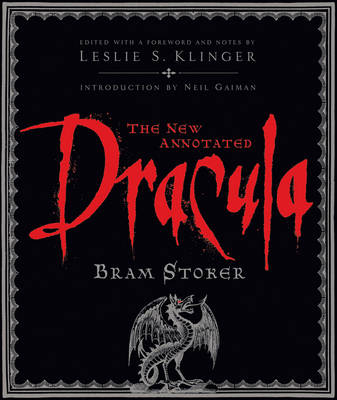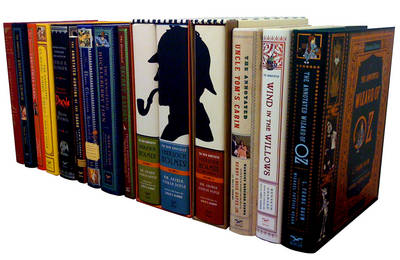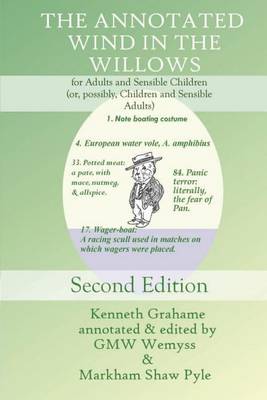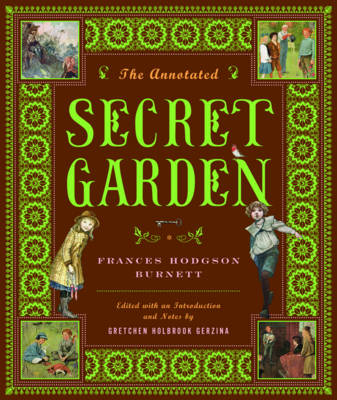The Annotated Books
5 primary works
Book 0
In his first work since his best-selling The New Annotated Sherlock Holmes, Leslie S. Klinger returns with this spectacular, lavishly illustrated homage to Bram Stoker's Dracula. With a daring conceit, Klinger accepts Stoker's contention that the Dracula tale is based on historical fact. Traveling through two hundred years of popular culture and myth as well as graveyards and the wilds of Transylvania, Klinger's notes illuminate every aspect of this haunting narrative (including a detailed examination of the original typescript of Dracula, with its shockingly different ending, previously unavailable to scholars). Klinger investigates the many subtexts of the original narrative-from masochistic, necrophilic, homoerotic, "dentophilic," and even heterosexual implications of the story to its political, economic, feminist, psychological, and historical threads. Employing the superb literary detective skills for which he has become famous, Klinger mines this 1897 classic for nuggets that will surprise even the most die-hard Dracula fans and introduce the vampire-prince to a new generation of readers.
Book 0
The Annotated Books Set
by Hans Christian Andersen, L. Frank Baum, Frances Hodgson Burnett, Lewis Carroll, Charles Dickens, Kenneth Grahame, Jacob Grimm, Wilhelm Grimm, Bram Stoker, and Arthur Conan Doyle
The Annotated Alice (by Lewis Carroll with illustrations by John Tenniel, edited by Martin Gardner): The Definitive Edition of The Annotated Alice combines the notes of Gardner's 1960 Annotated Alice with his 1990 update, More Annotated Alice, as well as additional new discoveries and updates drawn from Gardner's encyclopedic knowledge of the texts.
The Annotated Brothers Grimm (by Jacob and Wilhelm Grimm, edited and translated by Maria Tatar): The Annotated Brothers Grimm celebrates the richness and dramatic power of the legendary fables with forty stories in new translations by Maria Tatar—including "Little Red Riding Hood," "Cinderella," "Snow White," and "Rapunzel," plus tales that were previously excised, including a few bawdy stories and others that were removed after the Grimms learned that parents were reading the book to their children.
The Annotated Christmas Carol (by Charles Dickens with illustrations by John Leech, edited by Michael Patrick Hearn): With extensive annotations and reading notes, this is the first edition to combine the original text of 1843 with Dickens's Public Reading text, which had its world premiere in America in 1867 and had not been reprinted in nearly a century. Also included are rare photographs as well as the original Leech wood engravings and hand-colored etchings.
The Annotated Classic Fairy Tales (edited and translated by Maria Tatar): Tatar, a leading expert in the field of folklore and children's literature, guides readers through the stories, exploring their historical origins, their cultural complexities, and their psychological effects. Tatar presents twenty-six classic stories—including "Beauty and the Beast," "Little Red Hiding Hood," "Jack and the Beanstalk," and "The Little Mermaid." Over 300 often rare, mostly four-color photographs, paintings, and illustrations.
The New Annotated Dracula (by Bram Stoker, edited by Leslie S. Klinger): Traveling through two hundred years of popular culture and myth as well as graveyards and the wilds of Transylvania, Klinger's notes illuminate every aspect of this haunting narrative, including a detailed examination of the original typescript of Dracula, with its shockingly different ending, previously unavailable to scholars.
The Annotated Hunting of the Snark (by Lewis Carroll with illustrations by Henry Holiday, edited by Martin Gardner): A trove of new annotations and illustrations, uncovering some of the most confounding literary, linguistic, and mathematical references embedded in any of Lewis Carroll's many works. Included in this gorgeous, two-color volume is an introduction by Adam Gopnik, as well as Henry Holiday's distinctive, original illustrations, a substantial bibliography, and a suppressed drawing of the infamous Boojum.
The Annotated Hans Christian Andersen (by Hans Christian Andersen, edited and translated by Maria Tatar): Tatar celebrates the stories told by Denmark's "perfect wizard.” Andersen's most beloved tales, such as "The Emperor's New Clothes," "The Ugly Duckling," and "The Little Mermaid," are now joined by "The Shadow" and "Story of a Mother," mature stories that reveal his literary range and depth, showing exactly how Andersen became one of the world's ten most translated authors, along with Shakespeare, Dickens, and Marx.
The Annotated Huckleberry Finn (by Mark Twain with illustrations by E. W. Kemble, edited by Michael Patrick Hearn): Hearn's copious annotations draw on primary sources including the original manuscript, Twain's revisions and letters, and period accounts. Reproducing the original E. W. Kemble illustrations from the first edition, as well as countless archival photographs and drawings, some of them previously unpublished.
The Annotated Secret Garden (by Frances Hodgson Burnett, edited by Gretchen Holbrook Gerzina): Gerzina, the author of the definitive biography of Frances Hodgson Burnett, brings out aspects of Burnett's life that led her to write the much-loved tale read by generations of children, details of the Victorian England time period, attitudes toward children, and Burnett's spiritual leanings. With over one hundred illustrations, many in vibrant color.
The New Annotated Sherlock Holmes: The Complete Short Stories, in two slipcased volumes (by Sir Arthur Conan Doyle, edited by Leslie S. Klinger): In two elegantly slipcased volumes, Klinger, a leading world authority, reassembles Arthur Conan Doyle's 56 classic short stories in the order in which they appeared in late nineteenth- and early twentieth-century book editions. Inside, a cornucopia of insights: beginners will benefit from Klinger's insightful biographies of Holmes, Watson, and Conan Doyle; history lovers will revel in the wealth of Victorian literary and cultural details; Sherlockian fanatics will puzzle over tantalizing new theories; art lovers will thrill to the 700-plus illustrations.
The New Annotated Sherlock Holmes: The Novels, in a slipcased volume (by Sir Arthur Conan Doyle, edited by Leslie S. Klinger): The four classic novels of Sherlock Holmes available in a new slipcased edition. Klinger reassembles Doyle's four seminal novels (A Study in Scarlet, The Sign of Four, The Hound of the Baskervilles, and The Valley of Fear) in their original order, with over 1,000 new notes, 350 illustrations and period photographs, and tantalizing new Sherlockian theories.
The Annotated Uncle Tom's Cabin (by Harriet Beecher Stowe, edited by Henry Louis Gates, Jr. and Hollis Robbins): Declared worthless and dehumanizing by James Baldwin in 1949, Uncle Tom's Cabin has lacked literary credibility for fifty years. Now, in a ringing refutation of Baldwin, Henry Louis Gates Jr. demonstrates the literary transcendence of Harriet Beecher Stowe's masterpiece, providing new insights into emerging race-relation, women's, gay, and gender issues. With reproductions of rare prints, posters, and photographs, this book is also one of the most thorough anthologies of Uncle Tom images up to the present day. .
The Annotated Wind in the Willows (by Kenneth Grahame, edited by Annie Gauger): Discover the sheer joy of the original text, restored to the original 1908 version, illustrated with hundreds of full-color images—including the beloved drawings by E. H. Shepard and Arthur Rackham. This edition reproduces the original letters in their entirety and includes nearly a thousand delightful annotations on everything from automobiles (Toad drove an Armstrong Hardcastle Special Eight) and early motorcar etiquette to modern manifestations (Disneyland's Mr. Toad's Wild Ride).
The Annotated Wizard of Oz (by L. Frank Baum, with illustrations by W. W. Denslow, edited by Michael Patrick Hearn): Hearn, the world's leading Oz scholar, provides a spellbinding annotated edition that illuminates all of Oz's numerous contemporary references, provides fascinating character sources, and explains the actual meaning of the word "Oz." A facsimile of the rare 1900 first edition appears with the original drawings by W. W. Denslow—scrupulously reproduced to mimic their correct colors, using a different color for each region of Oz—as well as twenty-five previously unpublished illustrations.
Book 0
An instant bestseller upon its initial publication in 1908, The Wind in the Willows has become one of the beloved stories of all time. How could Ratty and Mole have known when they took to the river over one hundred years ago that they would begin a phenomenon that would produce one of the most oft-quoted lines in British literature, and inspire everyone from the creator of Winnie-the-Pooh to Pink Floyd? Drawing from more than a decade of research, Annie Gauger, one of the world's leading experts on Kenneth Grahame and The Wind in the Willows, now presents a fascinating new annotated edition that reintroduces readers to Otter, curmudgeonly Badger, and rollicking, boastful Toad, while revealing the secrets behind this treasured classic.
In The Annotated Wind in the Willows, readers will discover the sheer joy of the original text, restored to the original 1908 version, illustrated with hundreds of full-color images-including the beloved drawings by E. H. Shepard and Arthur Rackham. This edition also includes Shepard's famous map of the Wild Wood and rarely seen images by illustrators Graham Robertson, Paul Bransom, Nancy Barnhart, and Wyndham Payne.
In an illuminating preface, Gauger explains how Grahame came to write the novel, which began as a bedtime story and then became a series of letters he wrote to his son, Alastair. This edition reproduces the original letters in their entirety and includes nearly a thousand delightful annotations on everything from automobiles (Toad drove an Armstrong Hardcastle Special Eight) and early motorcar etiquette to modern manifestations (Disneyland's Mr. Toad's Wild Ride). She reveals how William John Cavendish Bentinck-Scott, the peculiar Fifth Duke of Portland, built an extensive network of underground tunnels, thus inspiring the character of Badger, and she puts Grahame's work in literary context, comparing him to Dickens, Rudyard Kipling, A. A. Milne, and Sir Arthur Conan Doyle. Finally, new to this edition, long buried in the Kenneth Grahame papers, are the notes, letters, and writings by Alastair Grahame and his governess, including several pieces by Kenneth Grahame himself that have never been published before.
With a stunning, lyrical tribute to Grahame by Brian Jacques, the internationally best-selling author of the Redwall series, The Annotated Wind in the Willows should prove a most beautiful and enduring tribute to Grahame's masterpiece.
Book 0
Book 0




